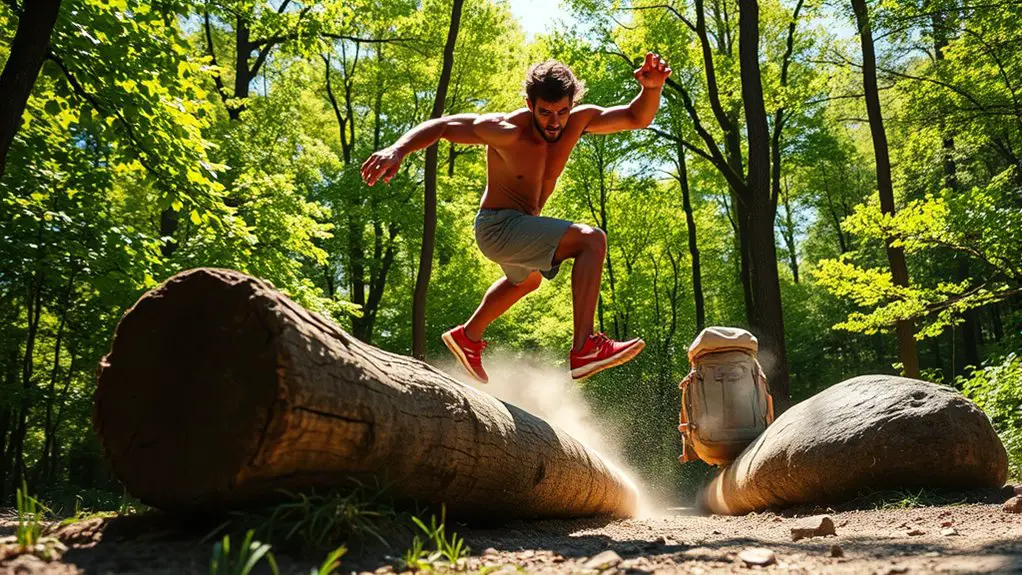To thrive outdoors, you'll want to focus on essential survival fitness techniques. Start with building core strength for stability, enhancing your cardiovascular endurance for long treks, and developing functional strength through bodyweight exercises. Don't forget to master navigation skills with a map and compass, and practice agility and balance for varied terrain. Also, learning effective fire-making techniques and improving flexibility can prevent injuries. There's so much more to explore to elevate your outdoor experience.
Building Core Strength for Stability
When you're traversing the great outdoors, having a strong core isn't just a bonus; it's crucial for maintaining stability and balance. Whether you're climbing rocky trails or maneuvering uneven terrain, core stability plays a significant role in how you move. A solid core helps you stay grounded, allowing you to react swiftly to changes in your environment.
To build that strength, incorporate core strength exercises into your routine. Think planks, Russian twists, and bicycle crunches. These moves not only target your abdominal muscles but also engage your back and hips, creating a powerhouse of support. You don't need fancy equipment—just your body weight and a bit of creativity to get started.
As you strengthen your core, you'll feel more confident exploring the wild. Additionally, a well-conditioned core helps prevent injuries by reducing strain on your body during outdoor activities. So, get out there, push your limits, and embrace the freedom of movement that a strong core provides.
Enhancing Cardiovascular Endurance for Long Treks
A strong core sets the stage for tackling long treks, but it's your cardiovascular endurance that will keep you moving over greater distances. To enhance your endurance, consider these techniques that fit right into your adventurous lifestyle:
- Interval Training: Incorporate short bursts of high-intensity effort followed by recovery periods. This boosts your aerobic capacity and prepares you for varied terrains.
- Endurance Pacing: Practice maintaining a steady pace over long distances. This helps you conserve energy and keeps fatigue at bay.
- Hill Workouts: Seek out inclines to build strength and power. Climbing hills mimics the challenges of outdoor trails.
- Cross-Training: Engage in different activities like cycling or swimming. This keeps your workouts fresh and targets various muscle groups, enhancing overall endurance. Additionally, interval training encourages personal expression while achieving fitness goals.
Developing Functional Strength Through Bodyweight Exercises
While you gear up for your outdoor adventures, developing functional strength through bodyweight exercises can be a game changer. These bodyweight routines don't require any fancy equipment, giving you the freedom to train wherever you are. By harnessing your own weight, you'll engage multiple muscle groups, enhancing your overall strength and stability.
Incorporating resistance training through exercises like push-ups, squats, and lunges helps build the kind of strength that's practical for real-world situations. You'll improve your balance and coordination, making it easier to navigate uneven terrain or carry your gear.
Plus, these workouts can be easily adjusted to match your fitness level, allowing you to progress at your own pace. Embrace the simplicity and effectiveness of bodyweight exercises, and you'll find yourself more prepared for any outdoor challenge that comes your way. Not only do these exercises provide improved strength and power, but they also enhance your control over your body for explosive movements. So, get moving and feel the empowerment that comes with functional strength!
Mastering Navigation Skills With Map and Compass
When you're out in the wild, knowing how to read a map and use a compass can make all the difference. You'll want to get familiar with map symbols and compass basics to navigate effectively. Let's explore some practical exercises that'll sharpen your skills and boost your confidence in the great outdoors.
Understanding Map Symbols
Maneuvering through the wilderness requires more than just instinct; understanding map symbols is essential for effective orientation. Mastering map reading and symbol identification can mean the difference between freedom and frustration. Here are four key symbols you should know:
- Trail Markers – Indicate paths and routes.
- Water Sources – Represent rivers, lakes, and streams.
- Elevation Contours – Show changes in terrain and hills.
- Campsites – Mark designated areas for resting or setting up camp.
Familiarizing yourself with these symbols will not only enhance your navigation skills but also boost your confidence as you explore the great outdoors. So grab a map, embrace the adventure, and let your spirit roam free!
Compass Basics Explained
Understanding map symbols is just the beginning of effective navigation in the wilderness; a compass is an essential tool that helps you pinpoint your exact location and direction. There are various compass types, like baseplate and lensatic, each designed for specific navigation needs. To master compass reading, start by familiarizing yourself with its components—like the needle, dial, and orienting arrow. Always hold the compass level, and align the needle with the north marking. Once you've set your bearing, you can confidently venture into the wild, knowing you're heading in the right direction. Remember, practice makes perfect, so take your compass on every adventure. Embrace the freedom of exploration, and let your newfound navigation skills guide you.
Practical Navigation Exercises
To truly master navigation skills with a map and compass, practicing practical exercises is essential. Here are some engaging activities to boost your landmark recognition and terrain awareness:
- Landmark Identification: Head out and identify prominent features like mountains, rivers, and trees. Use your map to locate them.
- Compass Course: Set a course using your compass, then steer towards various waypoints. Challenge yourself with new routes.
- Map Reading: Practice reading topographic maps. Focus on understanding elevation changes and contours.
- Night Navigation: Try finding your way by the stars or moonlight. This'll sharpen your skills and deepen your connection with nature.
Practicing Agility and Balance for Varied Terrain
As you explore the outdoors, honing your agility and balance becomes essential for traversing varied terrain. Whether you're maneuvering rocky paths, muddy trails, or steep inclines, having strong balance can prevent slips and falls, keeping your spirit of adventure alive. Incorporating balance drills into your routine, like single-leg stands or stability ball exercises, can greatly enhance your core strength and coordination. Agility courses, whether set up in your backyard or found in local parks, offer a fun way to improve your footwork and reaction time. You can sprint, jump, and weave through obstacles, mimicking the unpredictable nature of outdoor environments. Additionally, engaging in agility training techniques can further enhance your ability to navigate challenging terrains effectively.
Learning Fire-Making Techniques for Survival
Mastering fire-making techniques is a key skill for anyone venturing into the great outdoors. Whether you're camping, hiking, or just exploring, knowing how to start a fire can keep you safe and warm. Here are some essential fire starting methods to help you out:
Mastering fire-making is essential for outdoor adventurers, ensuring safety and warmth while exploring nature.
- Bow Drill: A traditional method that uses friction to create embers.
- Flint and Steel: Generates sparks that can ignite your tinder.
- Fire Plough: A simple technique involving a stick and a groove in wood.
- Tinder Selection: Choose dry materials like grass, leaves, or bark; they ignite easily.
Improving Flexibility to Prevent Injuries
While you're enjoying the great outdoors, improving your flexibility can be an essential factor in preventing injuries. You want to roam freely, climb, and explore without the fear of pulling a muscle. Incorporating dynamic stretching into your pre-adventure routine can greatly enhance your range of motion and prepare your body for the challenges ahead. Think of leg swings, arm circles, and torso twists—movements that get your blood flowing and muscles ready for action. Additionally, prioritizing mobility training can help you maintain joint health and improve your body's resilience, further reducing the risk of injury.
Establishing consistent flexibility routines can also help you maintain your mobility over time. Try yoga or simple stretches during breaks to keep your body limber. Not only will this help you stay injury-free, but it'll also enhance your overall experience in nature, allowing you to fully embrace the wild without limits. So, take a few moments each day to stretch, and you'll be ready to tackle any outdoor challenge that comes your way.
Incorporating Mental Resilience in Outdoor Challenges
When faced with the unpredictability of the outdoors, developing mental resilience can be just as essential as physical preparation. Your ability to handle challenges hinges on mental toughness and effective stress management. Here are four techniques to enhance your mental resilience while exploring the wild:
- Visualization: Picture yourself overcoming obstacles. This mental rehearsal can boost your confidence.
- Breath Control: Practice deep breathing to calm your mind and reduce stress during tough moments.
- Positive Affirmations: Create motivational phrases to remind yourself of your strengths and capabilities.
- Mindfulness: Stay present in the moment to combat anxiety about the unknown, focusing on what you can control.
Additionally, incorporating mindfulness practices can help you tap into your full potential and maintain clarity during challenges. Embracing these techniques can help you tackle any outdoor adventure with a fearless spirit. Embrace the wild and let your mental resilience guide you through every challenge.
Frequently Asked Questions
What Equipment Do I Need for Survival Fitness Training?
For survival fitness training, you'll need some essential equipment to get the most out of your workouts. Start with durable survival gear like a sturdy backpack for carrying weights and gear. A good pair of cross-training shoes can make a huge difference too. Don't forget a water bottle to stay hydrated and resistance bands for strength training. These training essentials will help you build endurance and strength while preparing you for any outdoor adventure.
How Often Should I Practice These Survival Fitness Techniques?
You should aim to practice your survival fitness techniques at least three times a week to truly hone your skills. By integrating various skills into your weekly routines, you'll build strength and confidence. Remember, consistency is key. Make it part of your lifestyle, and you'll find that not only are you getting fitter, but you're also gaining the freedom to tackle challenges head-on, whether in nature or everyday life.
Can I Do These Exercises at Home?
Absolutely, you can do these exercises at home! Home workouts offer flexibility, allowing you to create fitness routines that fit your schedule and space. Whether you're using bodyweight exercises or minimal equipment, you can build strength and endurance right in your living room. Embrace the freedom of training at home, and tailor your workouts to your preferences. It's all about making fitness a part of your daily life, wherever you are!
What Should I Eat to Boost My Outdoor Fitness?
Did you know that proper nutrition can boost your performance by up to 20%? To enhance your outdoor fitness, focus on nutrient timing and meal planning. Eating carbs before and protein after your workouts can maximize energy and recovery. Think about vibrant fruits, lean proteins, and whole grains to fuel your adventures. By planning your meals ahead, you'll have the freedom to enjoy the outdoors without worrying about energy dips or fatigue.
How Do I Track My Progress in Survival Fitness?
To track your progress in survival fitness, you can set fitness milestones that keep you motivated. Start by determining what you want to achieve, like improved strength or endurance. Use tracking methods like fitness apps, journals, or even simple checklists to monitor your workouts and achievements. Regularly review your progress to see how far you've come, and adjust your goals as needed. This way, you'll stay focused on your journey toward freedom in the outdoors.




